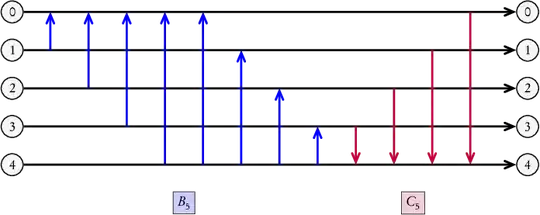I would like some reference about this infinitely nested radical expansion for all real numbers between $0$ and $2$.
I'll use a shorthand for this expansion, as a string of signs, $+$ or $-$, with infinite periods denoted by brackets.
$$2=\sqrt{2 + \sqrt{2 + \sqrt{2 + \dots}}}=(+)$$
$$1=\sqrt{2 - \sqrt{2 - \sqrt{2 - \dots}}}=(-)$$
$$0=\sqrt{2 - \sqrt{2 + \sqrt{2 + \dots}}}=-(+)$$
$$\phi=\sqrt{2 + \sqrt{2 - \sqrt{2 + \sqrt{2 - \dots}}}}=(+-)$$
$$\frac{1}{\phi}=\sqrt{2 - \sqrt{2 + \sqrt{2 - \sqrt{2 + \dots}}}}=(-+)$$
In general, the expansion can be found by a very easy algorithm:
- take any number in $(0,2)$, square it
- if the result $>2$ write $+$, if the result $<2$ write $-$
- subtract $2$ from the result, square, repeat
If on some step we get $2$ exactly, we just write $(+)$ and the expansion is finished.
Examples:
$$\pi-2=--+-++-+-+++++++-+-+---------+-+--+--+--+++---++++ \dots=1.141592653589793 \dots$$
Basically, $50$ terms of our expansion gave only $15$ correct decimal digits for $\pi$. But considering the expansion can be coded as binary, it's not so bad.
The convergence plot, and two binary plots for this $50$ terms can be seen below:
$$e-1=+-----+++-++-+---++-++++-+---++-+++-++++-++++---++ \dots=1.71828182845905 \dots$$
Do you know any reference about this expansion? Can every real number between $0$ and $2$ be expanded this way?
Is number $2$ special in this case, or can we make a similar expansion using some other number (and other power for the root)?
Edit
Now that I think about it, we can use the general expansion for $x \in [0,a]$:
$$x=\left(a \pm \left(a \pm \left(a \pm \dots \right)^p \right)^p \right)^p$$
$$a=2^{\frac{p}{1-p}}$$
For example:
$$\frac{1}{4}=\left(\frac{1}{4} + \left(\frac{1}{4} + \left(\frac{1}{4} + \dots \right)^2 \right)^2 \right)^2$$
$$\frac{3}{4}-\frac{\sqrt{2}}{2}=\left(\frac{1}{4} - \left(\frac{1}{4} - \left(\frac{1}{4} - \dots \right)^2 \right)^2 \right)^2$$
etc.
However, this case $p=2,~~~a=\frac{1}{4}$ is not just a random example, it's the only rational expansion of this kind. So I would say it's more important than the titular root expansion.
Edit
An interesting article that connects the nested roots of this kind to Chebyshev polynomials: http://www.sciencedirect.com/science/article/pii/S0022247X12003344


